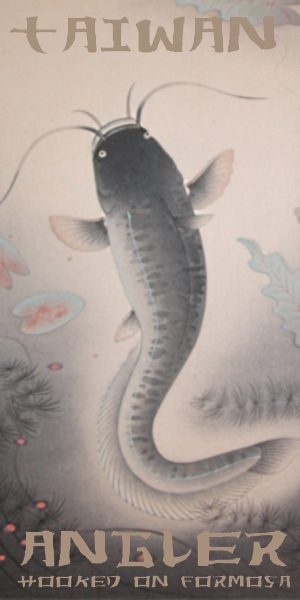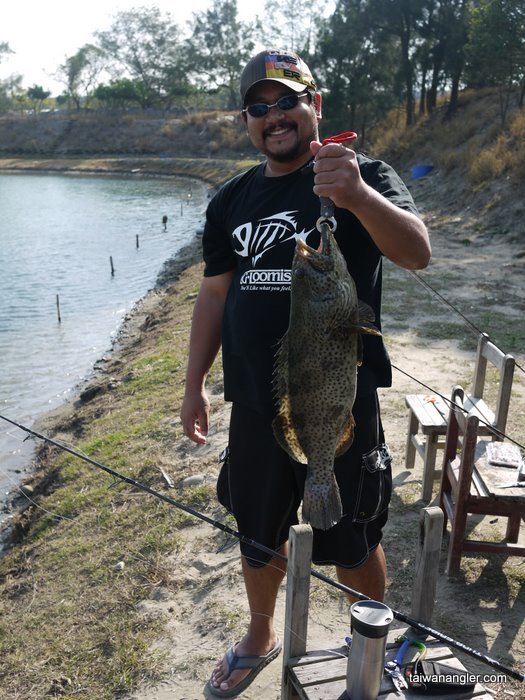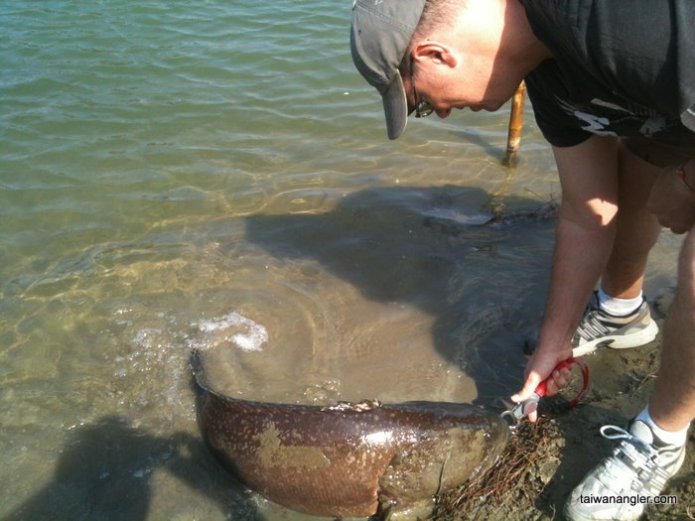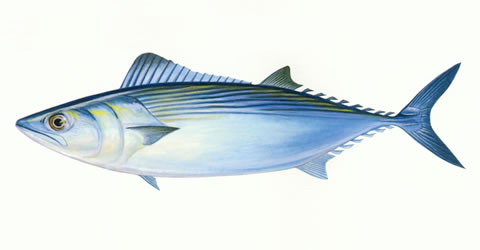 Chris Jackson |
Chris Jackson |  Post a Comment |
Post a Comment |  7 References | | tagged
7 References | | tagged  fishing video,
fishing video,  saltwater fishing,
saltwater fishing,  swordfish in
swordfish in  Video
Video

 Chris Jackson |
Chris Jackson |  Post a Comment |
Post a Comment |  7 References |
7 References |  Share Article | tagged
Share Article | tagged  fishing video,
fishing video,  saltwater fishing,
saltwater fishing,  swordfish in
swordfish in  Video
Video  Thursday, January 19, 2012 at 10:48AM
Thursday, January 19, 2012 at 10:48AM Not sure exactly where this Youtube video was shot, but guy featured pulls in a what looks like a nice little spanish mackeral shore jigging near a harbor entrance. From the size of the ships in the background, I'm guessing this is in Keelung or Kaohsiung.
 Monday, October 31, 2011 at 1:23PM
Monday, October 31, 2011 at 1:23PM I finally tried something this weekend that I have been planning to do for quite some time—visit one of the many saltwater fishing ponds along the eastern coast of Taiwan. An expat angler I met through this site who lives in Hsinchu county has been telling me about a pond he and his friends frequent in nearby Jhunan. This weekend I finally had time to take him up on the offer come down and give it a try.
 Our first fish was a "small" one landed by Austin.Up just before dawn on Sunday morning, I was soon heading down the highway for my 7 a.m. rendezvous with Austin, a Kiwi who, being unwed and unburdened with children (OK, a “burden” I happily accept), seems to find time for angling that I could only dream of. He is particularly keen on the saltwater variety and often makes it down to Green Island and other offshore spots for his favorite activity—jigging for amberjacks and tuna.
Our first fish was a "small" one landed by Austin.Up just before dawn on Sunday morning, I was soon heading down the highway for my 7 a.m. rendezvous with Austin, a Kiwi who, being unwed and unburdened with children (OK, a “burden” I happily accept), seems to find time for angling that I could only dream of. He is particularly keen on the saltwater variety and often makes it down to Green Island and other offshore spots for his favorite activity—jigging for amberjacks and tuna.
Once Austin’s gear was stored in the car, we headed to the fishing pond with a quick detour along the way for bait. The pond itself is tucked down a country road along an estuary not far from the Number 3 Highway. It would be difficult to locate without a guide or GPS. The Google satellite map shows it as a single pond, but it has since been divided into two.
One pond allows you to keep your catch, and anglers pay NT$1,200 to fish for the day. This “keeper pond” is stocked with sea bass, black sea bream (porgy), milk fish and several other species. The second pond is stocked with a few different species of large grouper, some tipping the scale at over 20 kg. You don’t get to keep these brutes, but for NT$200 you can spend the day testing your tackle and arm muscles wrestling them up to shore. And that’s exactly what we came to do.
After unpacking our gear, we staked out a corner of the pond that Austin said was particularly productive and got down to business. I was clear that the keeper pond was more popular with locals than the grouper pond as we were the only anglers on the catch-and-release side when we arrived. A few more anglers would show up as the day progressed, but never as many as the keeper side of things.
As we set about rigging up, I was beginning to feel a bit like a hunter that brought a sling shot on an elephant hunt. The heaviest rod I have is a 7’ medium-action bass rod. Austin had assured me that this would be fine since he had landed one of his biggest groupers on a light freshwater spinning combo. On this day, however, he would be favoring a thick saltwater popping rod. It felt a bit strange rigging my comparatively flimsy rod with 70 lb. leader and 8/0 hooks, but I was willing to play along.
Onto these massive hooks we threaded bloody six-inch fillets of mackerel. Austin said that there was no need to cast out to the middle of the pond since the groupers tend cruise along the edges when they are feeding. So, we tossed our baits a few meters out, opened the bails on our spinning reels and waited. It was a pleasant way to spend the morning. The sky was mostly clear and pines lining the levee provided shade and blocked some of the gusting wind. This bruiser was too heavy to lift with the lip grip.
This bruiser was too heavy to lift with the lip grip.
It wasn’t too long before something began stripping line off of Austin’s reel. He grabbed the rod and after a brief tussle, beached a “small” 7 or 8 kg. grouper. We popped the hook out, took a few photos and sent our first fish on its way. After this point, the strikes came to a sudden halt and the action cooled off for the next few hours. We were getting worried as midday approached and there had been no more strikes, since the hours around noon tend to be the slowest in the pond. Just around 11:30, several fish could be seen foraging around the edge of the pond. It wasn’t long before the line stripping off Austin’s reel. Graciously he waved me over to do the honors.
I gave the fish a few seconds to take the bait all the way it its mouth before snapping the bail closed and setting the hook. That did little to stop the grouper’s progress across the pond as it continued to take line. Drag singing and rod bent over, it may not have been a “wild” fish on the end of the line, but it was definitely fun worth the price of admission. Finally able to turn the fish around and gain some ground after a little back and forth, I was able to drag up onto the sandy shore a bruiser that Austin estimated at a little over 12 kg. Try as we might to lift him with my puny lip grip for a photo, he was back on the ground with a shake of his tail. We took a few shots on the ground and sent him on his way.
All in all it was a great half day of fishing. Austin said the action really picks up just before dusk. The grouper pond shuts down after sunset, but the keeper pond stays open into the night. I’ll definitely be heading back (with heavier tackle) to give it another go.
 Chris Jackson |
Chris Jackson |  Post a Comment |
Post a Comment |  1 Reference |
1 Reference |  Share Article | tagged
Share Article | tagged  grouper,
grouper,  pay ponds,
pay ponds,  saltwater fishing,
saltwater fishing,  saltwater pond in
saltwater pond in  Fishing Report
Fishing Report  Wednesday, September 21, 2011 at 10:38PM
Wednesday, September 21, 2011 at 10:38PM This popped up in my YouTube recommondations. Not much description with the video, but that looks like Kaohsiung fishing guru Mr. Kenneth in most of the shots.
 Chris Jackson |
Chris Jackson |  Post a Comment |
Post a Comment |  Share Article | tagged
Share Article | tagged  GT,
GT,  fishing in Taiwan,
fishing in Taiwan,  giant trevally,
giant trevally,  lure fishing,
lure fishing,  saltwater fishing in
saltwater fishing in  Video
Video  Wednesday, July 27, 2011 at 3:42PM
Wednesday, July 27, 2011 at 3:42PM Family: Scombridae
Scientific name: Sarda orientalis
Common names: striped bonito, oriental bonito, Mexican bonito
Chinese names: 齒鰆 (chih chun), 东方狐鲣, (dōngfāng hú jiān)
Habitat: Bonito usually congregate in schools close to coastal areas, over reefs and near islands.
Size range: While they have been recorded up to 102 cm, specimens in the 50 cm range are much more common.
Fast, aggressive, compact and wily — everything about the striped bonito says “fun” for the light tackle saltwater angler. They are like the guest you hope shows up at a drab party who can dj, dance and tell hilarious jokes, all while mixing cocktails. In other words, they are always welcome. Striped Bonito (Photo by Chinese Academy of Fisheries Sciences)
Striped Bonito (Photo by Chinese Academy of Fisheries Sciences)
On a size scale, bonitos occupy a space between mackerels and tunas. Don’t let their compact size fool you; they pack a lot of punch in their little bodies. The striped bonito can be distinguished from its slightly larger cousins the Pacific (Sarda chiliensis lineolata) and Australian (Sarda australis) by the greater concentration of vertical stripes running head to tail down the upper portion of its body.
Bonito feed primarily a marine crustaceans, small fish and squid. Wherever one finds large schools of baitfish near the surface in Taiwan, the striped bonitos are usually not far off. They are found along every coastal area of Taiwan and the outlying islands.
A wide variety of tactics and tackle options are open to bonito anglers. Trolling spoons and feathered lures works well. In Taiwan, where trolling isn’t always an option for the average angler, still fishing from a boat or shore with metal jigs, stick lures, spoons and anything that imitates an injured baitfish should result in interest if bonito are in the vicinity.
Interest doesn’t always guarantee a hookup or even a strike, however. Aggressive hunters they may be, but striped bonito can be crafty as well, and get skittish once one of their fellow schoolmates is hooked. Individual fish will sometimes pursue, even bump a lure before breaking off the attack at the last second if something doesn’t look right. Low visibility leaders are recommended, and be prepared to change lure color, retrieve speed and depth to find what the bonito are responding to given the immediate conditions.
Of course, all their clever caution goes out the window when a school goes into a feeding frenzy, and then the fish will seem to strike at anything thrown their way. Once hooked, especially on a lighter rod, get ready for a an exciting little tussle.
As an eating fish, bonito sometimes don’t get the respect they are due, especially in western regions where some find them too strong tasting. Smoked or barbecued, they can be delicious. Better yet, try some bonito sashimi. If you prefer milder flavor, just cut away the darker red flesh.